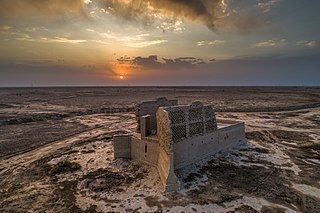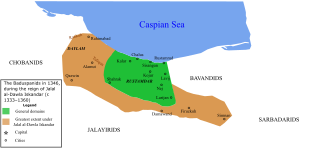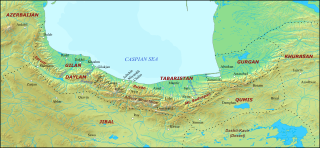
The Hashimids were an Arab family who ruled over Bab al-Abwab (Darband) in Daghestan from 869 to 1075. [1]

The Hashimids were an Arab family who ruled over Bab al-Abwab (Darband) in Daghestan from 869 to 1075. [1]

The Tahirid dynasty was an Arabized Sunni Muslim dynasty of Persian dehqan origin that ruled as governors of Khorasan from 821 to 873 as well as serving as military and security commanders in Abbasid Baghdad until 891. The dynasty was founded by Tahir ibn Husayn, a leading general in the service of the Abbasid caliph al-Ma'mun. For his support of al-Ma'mun in the Fourth Fitna, he was granted the governance of Khorasan.

The Saffarid dynasty was a Persianate dynasty of eastern Iranian origin that ruled over parts of Persia, Greater Khorasan, and eastern Makran from 861 to 1002. One of the first indigenous Persian dynasties to emerge after the Islamic conquest, the Saffarid dynasty was part of the Iranian Intermezzo. The dynasty's founder was Ya'qub bin Laith as-Saffar, who was born in 840 in a small town called Karnin (Qarnin), which was located east of Zaranj and west of Bost, in what is now Afghanistan. A native of Sistan and a local ayyār, Ya'qub worked as a coppersmith (ṣaffār) before becoming a warlord. He seized control of the Sistan region and began conquering most of Iran and Afghanistan, as well as parts of Pakistan, Tajikistan and Uzbekistan.

The Lakhmid dynasty, referred to in Arabic as al-Manādhirah or Banu Lakhm, was an Arab kingdom in Southern Iraq and Eastern Arabia, with al-Hirah as their capital, from the late 3rd century to 602 AD/CE. They were generally but intermittently the allies and clients of the Sasanian Empire, and participant in the Roman–Persian Wars. While the term "Lakhmids" has also been applied to the ruling dynasty, more recent scholarship prefers to refer to the latter as the Naṣrids.
Sayyida Shirin, also simply known as Sayyida (سیدا), was a Bavandid princess, who was the wife of the Buyid amir (ruler) Fakhr al-Dawla.

The Kakuyids were a Shia Muslim dynasty of Daylamite origin that held power in western Persia, Jibal and Kurdistan. They later became atabegs (governors) of Yazd, Isfahan and Abarkuh from c. 1051 to 1141. They were related to the Buyids.

Alp-Tegin, or Alptekin, was a Turkic slave commander of the Samanid Empire, who would later become the semi-independent governor of Ghazna from 962 until his death in 963.

Rawwadid, Ravvadid, or Banū Rawwād (955–1071) was a Sunni Muslim Kurdish dynasty, centered in the northwestern region of Adharbayjan (Azerbaijan) between the late 8th and early 13th centuries.

Daysam ibn Ibrahim al-Kurdi was a Kurdish commander who occasionally ruled Adharbayjan between 938 and 955 during the power struggle that ensured after the fall of the Sajid dynasty.

Sistān, also known as Sakastān and Sijistan, is a historical region in present-day south-eastern Iran, south-western Afghanistan and north-western Pakistan. Largely desert, the region is bisected by the Helmand River, the largest river in Afghanistan, which empties into the Hamun Lake that forms part of the border between Iran and Afghanistan.

The Shirvanshahs were the rulers of Shirvan from 861 to 1538. The first ruling line were the Yazidids, an originally Arab and later Persianized dynasty, who became known as the Kasranids. The second ruling line were the Darbandi, distant relatives of the Yazidids/Kasranids.

The Afrighids were a native Khwarezmian Iranian dynasty who ruled over the ancient kingdom of Khwarazm. Over time, they were under the suzerainty of the Sasanian Empire, the Hephthalite Empire, the Göktürk Khaganate, the Umayyad Caliphate, Abbasid Caliphate and the Samanid Empire.
The Yazidids or Mazyadids or Shaybanids, were an Arab family what came to rule over the region of Shirvan in the mid 9th century. Starting from Haytham ibn Khalid's assumption of the ancient Iranian title of Shirvanshah in 861, they practically broke free of Abbasid control and was therefore out of scope for most chroniclers of the Caliphate.

The term Iranian Intermezzo, or Persian Renaissance, represents a period in history which saw the rise of various native Iranian dynasties in the Iranian Plateau after the 7th-century Muslim conquest of Persia and the fall of the Sasanian Empire. The period is noteworthy since it was an interlude between the decline of Abbāsid rule and power by Arabs and the "Sunni Revival" with the 11th-century emergence of the Seljuq Turks. The Iranian revival consisted of Iranian support based on Iranian territory and most significantly a revived Iranian national spirit and culture in an Islamic form, although there were some Iranian Zoroastrian movements rejecting Islam altogether as a religion. It also focused on reviving the Persian language, the most significant Persian-language literature from this period being Shahnameh by Ferdowsi. The Iranian dynasties and entities which comprise the Iranian Intermezzo are the Tahirids, Saffarids, Sajids, Samanids, Ziyarids, Buyids, Sallarids, Rawadids, Marwanids, Shaddadids, Kakuyids, Annazids and Hasanwayhids.
BukhtnassarAli was the fourteenth Shirvanshah, ruling from 1049 to 1050. He was the successor and nephew of Qubad. His father Ahmad b. Yazid was a son of Yazid II. He was immediately deposed by his uncle, Sallar. Bukhtnassar managed to escape but was captured and executed by forces of Sallar near Baylaqan.

The Salghurids, also known as the Atabegs of Fars, were a Persianate dynasty of Salur Turkoman origin that ruled Fars, first as vassals of the Seljuks then for the Khwarazm Shahs in the 13th century.

The Baduspanids or Badusbanids, were a local Iranian dynasty of Tabaristan which ruled over Ruyan/Rustamdar. The dynasty was established in 665, and with 933 years of rule as the longest dynasty in Iran, it ended in 1598 when the Safavids invaded and conquered their domains.
This is a family tree of the Bavandid rulers, and their ancestors.

The Principality of Chaghaniyan, known in Arabic sources as al-Saghaniyan, was a part of the Hephthalite Confederation from the 5th to the 7th century CE. After this, it was ruled by a local, presumably Iranian dynasty, which governed the Chaghaniyan region from the late 7th-century to the early 8th-century CE. These rulers were known by their titles of “Chaghan Khudah”.

Ruyan, later known as Rustamdar (رستمدار), was the name of a mountainous district that encompassed the western part of Tabaristan/Mazandaran, a region on the Caspian coast of northern Iran.